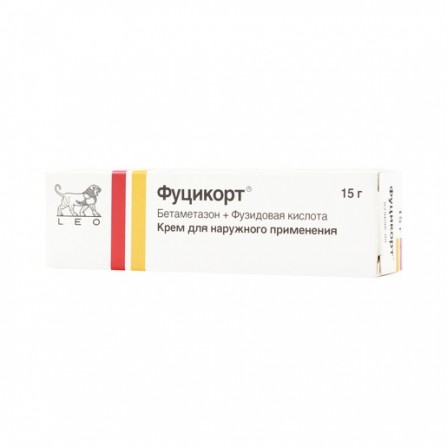More info
Active ingredients
Betamethasone + Fuzidovaya acid
Release form
Cream
Composition
1 g of cream contains: Active ingredient: fusidic acid hemihydrate 20.4 mg, which corresponds to the content of fusidic acid anhydrous 20 mg; betamethasone valerate 1.214 mg, which corresponds to the content of betamethasone 1 mg. Adjuvants: macrogol cetostearate - 18 mg, cetostearyl alcohol (cetyl alcohol 60%, stearyl alcohol 40%) - 72 mg, chlorocresol - 1 mg, sodium dihydrogen phosphate dihydrate - 3 mg liquid paraffin - 60 mg, soft white paraffin (contains about 10 ppm of α-tocopherol) - 150 mg, sodium hydroxide - qs, purified water - up to 1 g
Pharmacological effect
Fucicort is a combination drug containing betamethasone glucocorticosteroid and fusidic acid, which has an antibacterial effect. Betamethasone belongs to the group of strong glucocorticosteroids (group III) and exerts its pharmacological action by suppressing local immune reactions, including vasodilation, puffiness and painful sensations. Fuzidovaya acid - an antibiotic with predominant activity against gram-positive bacteria. In particular, fusidic acid has activity against bacteria Staphylococcus aureus, Propionibacterium acnes and Corynebacteria, and also inhibits protein synthesis in bacteria. After 30 years of use, resistance of bacteria to fusidic acid is rarely observed (1-3%). Most commonly, bacteria resistant to penicillin and other antibiotics are susceptible to fusidic acid.
Pharmacokinetics
When applied to the skin, absorption of betamethasone can lead to systemic effects, especially when applied to large areas of inflamed skin or under occlusive dressings. With the external application of the drug Fucicor betamethasone absorption through intact skin is less than 2%. The amount of absorbed betamethasone is metabolized in the liver and excreted through the kidneys. Systemic absorption of fusidic acid is negligible.
Indications
Dermatitis, allergic eczema and toxidermia infected with microorganisms susceptible to fusidic acid.
Contraindications
Hypersensitivity to the components of the drug. Considering the presence of a glucocorticosteroid in the composition of the drug Fucicort, the drug is contraindicated in: Rosacea Perioral dermatitis Young acne Primary bacterial, viral and fungal skin diseases Skin tuberculosis, syphilis (skin manifestations) Children under one year
Precautionary measures
It is necessary to take the drug with caution in case of perianal or genital pruritus. Fucicort should be used with caution in large areas of the skin, under occlusive dressings, face, areas operely skin. Do not apply the drug to open wounds and mucous membranes. It should be used with caution in the periorbital area, as this may develop glaucoma.
Use during pregnancy and lactation
In pregnancy: Clinical data regarding the use of the drug Fucicort during pregnancy and lactation are not available. Animal experiments do not show the teratogenic effect of fusidic acid, but show this effect when using glucocorticosteroids. The safety of using external corticosteroid therapy during pregnancy has not been established; this group of drugs should be used only if the use of their drugs for the mother outweighs any potential risks to the fetus. Pregnant women should not use this group of drugs in large doses or for a long time. During lactation: It is possible to use the drug Fucicort during lactation. Women during lactation should use Fucicort only on the recommendation of a doctor. Glucocorticosteroids are excreted in breast milk, but the likelihood of their effect on an infant being fed is very small when applied topically to a limited area of skin. If long-term treatment or the use of high doses of the drug is indicated, breastfeeding should be stopped. In the period of lactation should not be applied cream on the mammary glands.
Dosage and administration
For external use. Adults and children: apply a thin layer of cream 2-3 times a day. The course of treatment: no more than 2 weeks.
Side effects
Side effects are classified by frequency: most frequent> 1/10 frequent> 1/100 and <1/10 infrequent> 1/1000 and <1/100 rare> 1/10000 and <1/1000 very rare <1 / 10,000 Immune system disorders: Unknown frequency: allergic reactions From the skin and skin appendages: Infrequent: rash, exacerbation of eczema, skin irritation, itching, burning sensation or tingling of the skin. Frequency unknown: skin atrophy, contact dermatitis, urticaria, erythema, dry skin.Although these reactions have not been reported in clinical studies of the drug Fucicort, external use of glucocortico steroids can lead to telangiectasias and striae, especially with prolonged use. As in the case of other glucocorticosteroids, folliculitis (steroid acne), hypertrichosis, perioral dermatitis, depigmentation, hemorrhagic rash, rosacea, prickly heat, maceration of the skin and systemic effects of glucocorticosteroids are possible.
Overdose
Excessive long-term external treatment with glucocorticosteroids can suppress the function of the pituitary and adrenal glands, which can lead to secondary (usually reversible) adrenal insufficiency. In this case, symptomatic therapy may be indicated.
Interaction with other drugs
Not known
special instructions
Bacterial resistance associated with the use of fusidic acid is noted. As with all antibiotics, excessive or repeated use may increase the risk of developing antibiotic resistance. If the use of Fucicort cream causes irritation or excessive sensitivity of the skin, you should stop using it and begin another appropriate treatment. In case of termination of treatment, the appearance of withdrawal syndrome, manifested in the form of redness, burning sensation or tingling of the skin or exacerbation of psoriasis, is possible. These phenomena can be prevented with the gradual withdrawal of the drug. Due to the fact that children have a larger ratio of surface area and body weight than adults, children are at greater risk of suppressing the function of the hypothalamic-pituitary-adrenal system and the development of Cushing's syndrome when using any glucocorticosteroids of local action. Long-term treatment of children with GKS can lead to impaired growth and development. Children should receive a minimum dose of the drug, sufficient to achieve the effect. After prolonged external treatment with potent corticosteroids, atrophic changes are most often found on the face, the external genital organs, the inner side of the upper and lower extremities, compared with other sites. The drug contains chlorocresol, which can cause allergic reactions, as well as cetostearyl alcohol, which can cause local skin rashes (for example, contact dermatitis).





